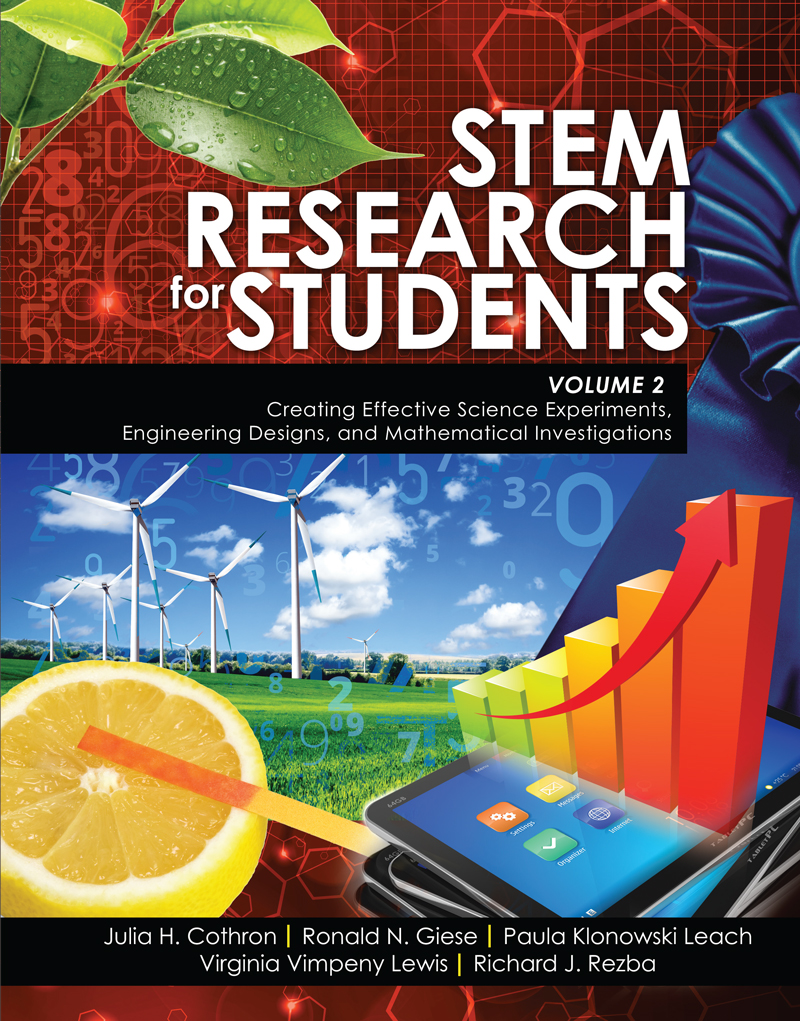STEM Research for Students Volume 2: Creating Effective Science Experiments, Engineering Designs, and Mathematical Investigations
Author(s): Julia H Cothron , Ronald N Giese , Paula Klonowski Leach , Virginia Vimpeny Lewis , Richard J Rezba
Edition: 1
Copyright: 2016
Pages: 376
Based on years of experience and prior publications, the two-volume book, STEM RESEARCH for STUDENTS, is a vital resource for K-12 teachers, higher education faculty, and their students.
In Volume Two, students build upon a strong foundation to create original STEM projects:
- Brainstorm ideas for projects;
- Analyze and address the safety risks involved in a project;
- Use the library and Web to expand understanding and develop a valid idea;
- Conduct a group mini-project which involves readily-available materials in the classroom, on a field site, or at a community location.
- Use algebra to represent patterns and develop mathematical models;
- Use statistics to detect the significance of relationships; and
- Communicate project findings through formal papers, visual presentations, and interactions with peers or judges.
STEM Research for Students, Volume 2 is:
- Student friendly! Each chapter is carefully sequenced and contains a variety of formative assessment tools. Key definitions are included in an appendix. Essential foundational knowledge from Volume 1 is clearly referenced.
- STEM encompassing! Students have multiple opportunities to make connections by applying information from the various chapters to original projects.
- Teacher enhanced! Each chapter contains learning objectives and assessment tools – checklists or rubrics. Answers to the practice sets are available on a secure Kendall Hunt web site.
- Standards aligned! All chapters are aligned with the Next Generation Science Standards, Common Core Standards for Mathematics and Literacy in Science and Technical Subjects, and the International Standards for Technology in Education Standards for Students.
Available in print and e-Book formats, STEM Research for Students, Volume 2, may be used:
- As a supplemental text in middle school, high school, and introductory college courses;
- As core text for research classes and STEM clubs where students are ready to engage in group or individual projects:
- For pre-service and in-service teachers of science, mathematics, career and technical courses, and gifted students;
- As a resource for all teachers involved with experiments, engineering designs, mathematical investigations, and competitive STEM projects.
The companion volume, STEM Research for Students, Volume 1, is a resource for students to acquire or strengthen the foundational knowledge necessary to engage in an original project.
Preface
Authors and Contributors
Acknowledgments
PART FOUR: DESIGNING, CONDUCTING, AND REPORTING EXPERIMENTS
Chapter 9 Brainstorming Experimental Ideas
Chapter 10 Analyzing and Addressing Safety Risks
Chapter 11 Implementing a Science Mini-Project
Chapter 12 Writing Formal Scientific Papers
PART FIVE: ENGINEERING TO MEET HUMAN NEEDS
Chapter 13 Conducting Engineering Tests
Chapter 14 Implementing an Engineering Mini-Project
PART SIX: USING MATHEMATICS TO DETECT PATTERNS AND RELATIONSHIPS
Chapter 15 Using Algebra to Represent Patterns
Chapter 16 Using Statistics to Detect the Significance of Relationships
Chapter 17 Implementing and Reporting Mathematical Investigations
PART SEVEN: EXPLORING STEM COMPETITIONS
Chapter 18 Participating in STEM Competitions
APPENDIX
A Correlations With Nationwide Standards
B Definitions of Key Terms
INDEX
Based on years of experience and prior publications, the two-volume book, STEM RESEARCH for STUDENTS, is a vital resource for K-12 teachers, higher education faculty, and their students.
In Volume Two, students build upon a strong foundation to create original STEM projects:
- Brainstorm ideas for projects;
- Analyze and address the safety risks involved in a project;
- Use the library and Web to expand understanding and develop a valid idea;
- Conduct a group mini-project which involves readily-available materials in the classroom, on a field site, or at a community location.
- Use algebra to represent patterns and develop mathematical models;
- Use statistics to detect the significance of relationships; and
- Communicate project findings through formal papers, visual presentations, and interactions with peers or judges.
STEM Research for Students, Volume 2 is:
- Student friendly! Each chapter is carefully sequenced and contains a variety of formative assessment tools. Key definitions are included in an appendix. Essential foundational knowledge from Volume 1 is clearly referenced.
- STEM encompassing! Students have multiple opportunities to make connections by applying information from the various chapters to original projects.
- Teacher enhanced! Each chapter contains learning objectives and assessment tools – checklists or rubrics. Answers to the practice sets are available on a secure Kendall Hunt web site.
- Standards aligned! All chapters are aligned with the Next Generation Science Standards, Common Core Standards for Mathematics and Literacy in Science and Technical Subjects, and the International Standards for Technology in Education Standards for Students.
Available in print and e-Book formats, STEM Research for Students, Volume 2, may be used:
- As a supplemental text in middle school, high school, and introductory college courses;
- As core text for research classes and STEM clubs where students are ready to engage in group or individual projects:
- For pre-service and in-service teachers of science, mathematics, career and technical courses, and gifted students;
- As a resource for all teachers involved with experiments, engineering designs, mathematical investigations, and competitive STEM projects.
The companion volume, STEM Research for Students, Volume 1, is a resource for students to acquire or strengthen the foundational knowledge necessary to engage in an original project.
Preface
Authors and Contributors
Acknowledgments
PART FOUR: DESIGNING, CONDUCTING, AND REPORTING EXPERIMENTS
Chapter 9 Brainstorming Experimental Ideas
Chapter 10 Analyzing and Addressing Safety Risks
Chapter 11 Implementing a Science Mini-Project
Chapter 12 Writing Formal Scientific Papers
PART FIVE: ENGINEERING TO MEET HUMAN NEEDS
Chapter 13 Conducting Engineering Tests
Chapter 14 Implementing an Engineering Mini-Project
PART SIX: USING MATHEMATICS TO DETECT PATTERNS AND RELATIONSHIPS
Chapter 15 Using Algebra to Represent Patterns
Chapter 16 Using Statistics to Detect the Significance of Relationships
Chapter 17 Implementing and Reporting Mathematical Investigations
PART SEVEN: EXPLORING STEM COMPETITIONS
Chapter 18 Participating in STEM Competitions
APPENDIX
A Correlations With Nationwide Standards
B Definitions of Key Terms
INDEX

